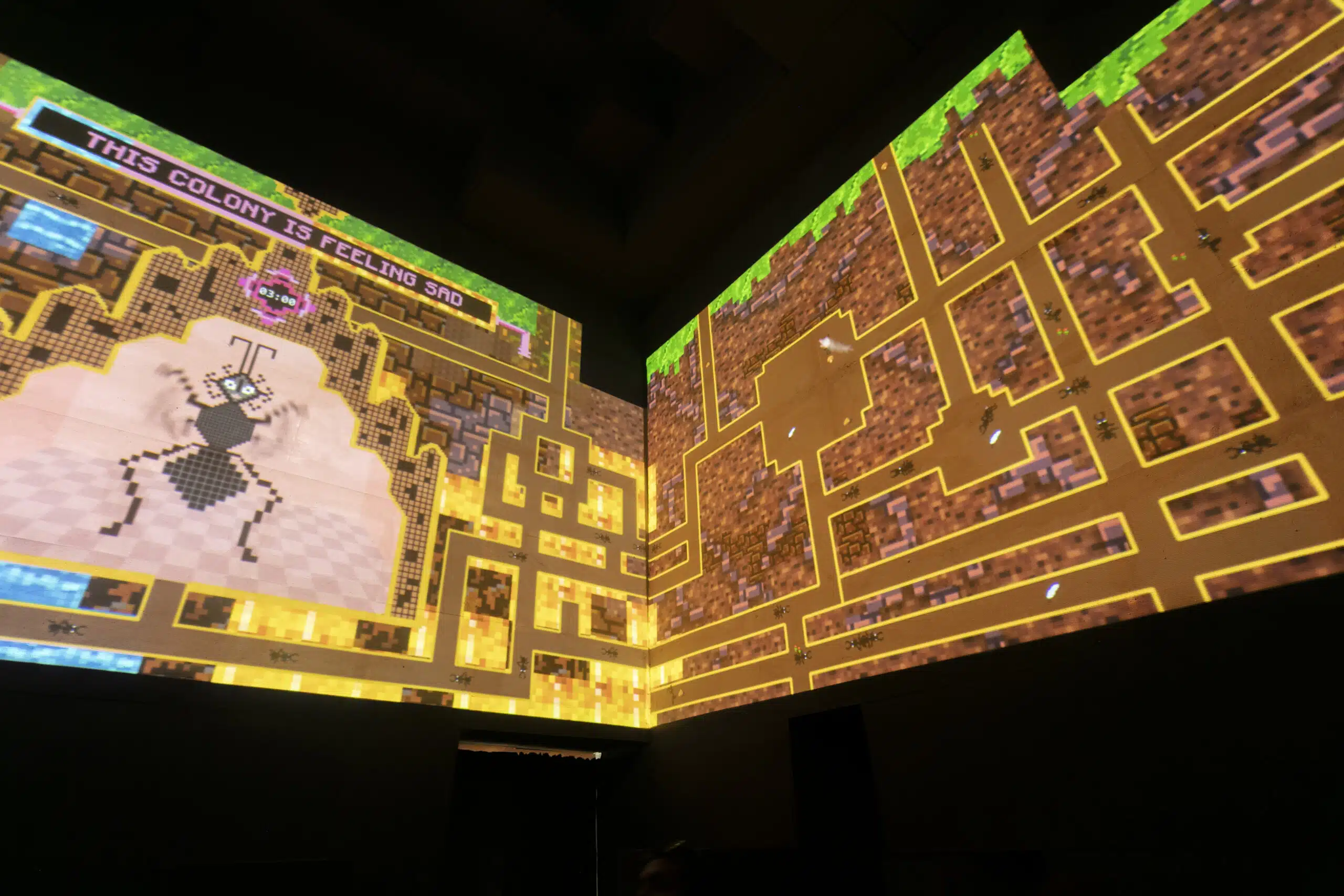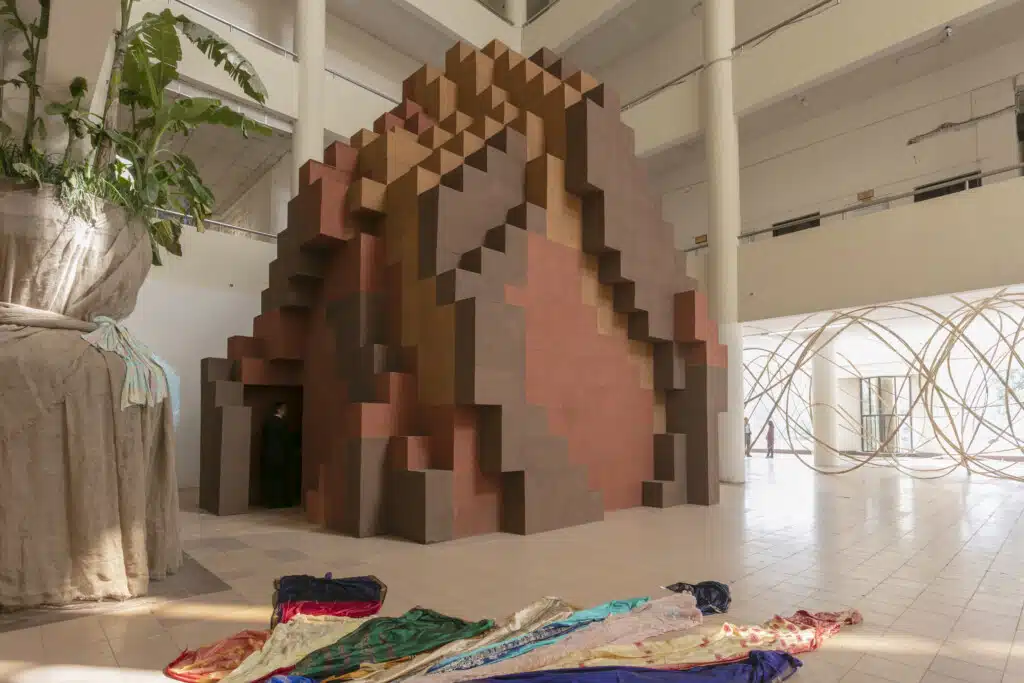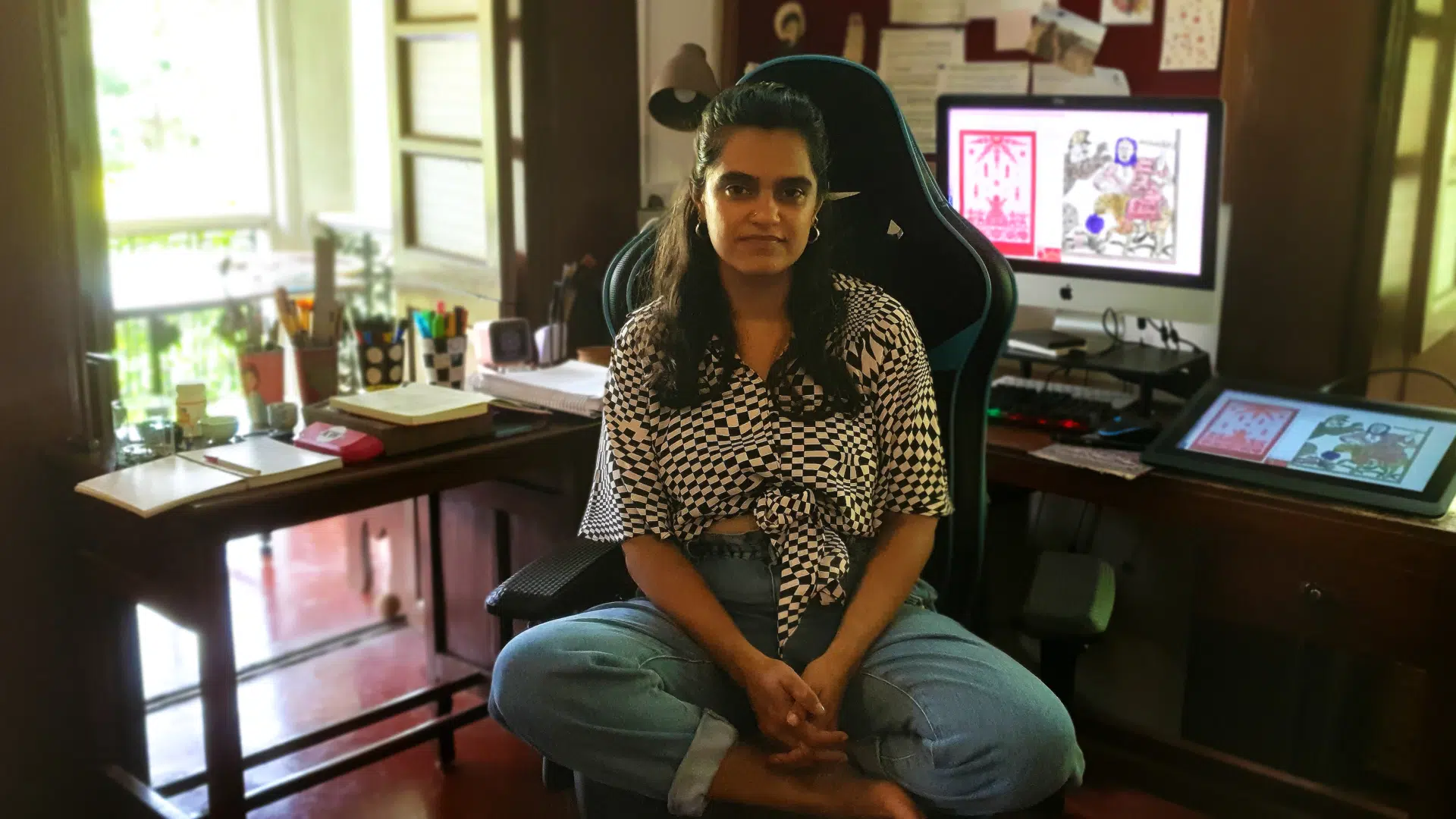Afrah Shafiq spends hours on end researching and working in a “gamer” chair in her studio, a room in her home in North Goa that she shares with her husband and beloved cat, Tara. An artist who has always been interested in working with digital forms, from illustration to interactive websites and video games, Shafiq interprets her world — be it the specific and diverse colonial histories of Goa and India or the natural rhythms of ant colonies and domestic work — through the language of code, algorithm, loop and glitch. And vice versa: in her work, a code also becomes a textile weave, a dot matrix becomes a cross-stitch, and AI takes on an aspect of the divine.
Here the artist brings us into her studio, full of remnants of the past and portals to the future.
Where do you live?
I live and work in an area called Torda, in Salvador do Mundo, North Goa. My studio is right across the Torda Creek, which is what I love most about living in this area. I like to spend time close to the water, either taking walks near the mangroves or sitting by the sluice gates. Especially when I am too in my head or stuck in my process, being here helps me feel expansive.
I was born and brought up in Bangalore, and I wasn’t really too much of a ‘nature person’ until I moved here about seven years ago. But living in Goa has taught me to slowly notice the way seasons change, natural cycles play out, what creatures come forth at what time of the year and what processes are followed in the village to respond to those changes. No matter what, every morning the poder and the fish seller will come. You know all the neighbourhood dogs and their individual politics. In your lane everyone knows each other, they talk to one another, there is a coming and going into each other’s homes… There is a time of the year for frogs, and there is a time of the year for fireflies. In the weeks before the monsoon everyone will be on the roof fixing things. The football lily will burst, just for those few days, at just that time of the year. All of these cycles are somehow helping me find my own rhythm.
 Afrah Shafiq’s studio features a gamer chair in the midst of a 90-year old Indo-Portuguese style house with heritage architecture and antique furniture. Image courtesy of the artist.
Afrah Shafiq’s studio features a gamer chair in the midst of a 90-year old Indo-Portuguese style house with heritage architecture and antique furniture. Image courtesy of the artist.
Where do you work?
In the current physical setup, my studio is an extra room in my house that has its own entrance. The house itself is quite special — one of the wooden beams has a date marking of 1934 so it’s almost 90 years old! It’s a typical Indo-Portuguese style house with high ceilings, oyster shell windows, red oxide flooring and an expansive balcão. It’s my landlady’s ancestral home and she left behind all the original furniture for us to use, which has some very intricate and gorgeous detailing. The studio has two large windows where I can see the creek from one of them and a bimbli tree in the garden from the other.
Since I largely make multimedia and digital forms, a lot of my work happens between my computer, a pen tab and several linked data drives that hold all the archival aspects of my projects. So when I travel, which is quite often, my studio can quite easily travel with me on my computer.
“Sometimes, I think of myself as a combination of a data scientist and a detective. I sift through large amounts of material but I am always trying to find things that are not so apparent in them… an invisible core.”
What happens in the studio?
Since a lot of my work is research and archive-based, I spend a considerable chunk of my days reading, note taking and mind mapping — sometimes, I think of myself as a combination of a data scientist and a detective. I sift through large amounts of material but I am always trying to find things that are not so apparent in them… an invisible core. Which means that I really need to spend long uninterrupted hours with my material to get into a zone. Once I am able to see the shape of what I want to say, I am in production mode, which is a completely different phase. Since I make interactive video and mutli-media work, production involves a lot of moving parts and often several other people. I have a set of regular collaborators who work on the sound, music and programming end of things, so in that phase, studio time involves a lot of video calls and online hang-outs. When I am working on making something tactile, the studio shape shifts based on what is going on, oscillating between cutting glass or making custom electronics, for example.

 Afrah Shafiq’s Where do the ants go? was installed at the 2023 Dhaka Art Summit as a three-channel video work in which players could interact with a digital colony of ants inside a large-scale ‘ant-hill’ sculpture. Images courtesy of the artist.
Afrah Shafiq’s Where do the ants go? was installed at the 2023 Dhaka Art Summit as a three-channel video work in which players could interact with a digital colony of ants inside a large-scale ‘ant-hill’ sculpture. Images courtesy of the artist.
What are you working on currently?
I have my first solo show coming up soon, at Experimenter in Kolkata, and I’ve been working quite intensely towards that. The show takes off from a longer research project of mine around illustrated children’s books from the Soviet Union that were very popular in India between the 60’s to late 80’s. I released a game called Nobody Knows For Certain, around this research about a year ago. And for this upcoming show I am exploring some of the related worlds that I encountered while I was researching for the game. For instance, through the folktales and their associated imagery, I have been thinking about the wedding day as a day of mourning. I am now making a new game about a bride who cannot stop crying where I bring together bridal embroideries from the Slavic tradition and women’s mourning songs, among other things.
I have also been working on a longer video game project called Where do the ants go?, that is a multiplayer game about ants and data, echo chambers on the internet and feeling loops in the brain. It’s a two-year long project that I started last year. I showed one iteration of it already at the 2023 Dhaka Art Summit and I’m now working towards the second iteration, which will materialise in São Paulo soon.
Do you think you will stay here?
If everything goes well, and we aren’t asked to leave, I would love to live here for a long time. I’m very attached to this neighbourhood. But in terms of a studio space, I do think in the long-term future, it might be nice to build a shared working space with other artists, in addition to having my own space at home. I think that would be a really nice way to create an ecosystem where artists can learn from each other, provide support, and perhaps even make art together.
Afrah Shafiq was born in 1989 in Bengaluru, India, and currently lives and works in Goa. Her work will be shown by Experimenter at India Art Fair 2024.


